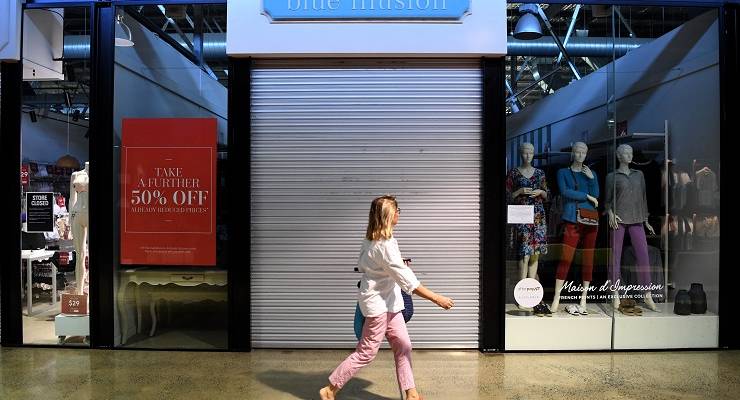
Shopping malls were once regarded as palaces of modernism. Now they are facing decay.
As COVID-19 triggers widespread store closures across a range of big-name retail brands, analysts are predicting as many as one in two shops could be shuttered over coming months.
“We’ve been talking about the retail apocalypse for years,” marketing lecturer Jason Pallant at Swinburne University told Crikey. “This is the closest we’ve got.”
Retail sales suffered a 17.9% fall in April, their worst ever monthly decline. The question now is whether shopping malls, an inextricable part of modern life for decades, are dying or going through a transformation.
David Jones, one of the oldest continuously operating department stores in the world, announced last week it would close some of its 48 stores and sell off some of its property holdings as it grappled with a $500 million debt. It was the latest in a string of grim announcements from brick-and-mortar retailers who have been hit first by a slow Christmas, then bushfires, and now the pandemic.
Target, owned by $44 billion Wesfarmers, said it would also shut up to 75 stores across the country, and Flight Centre, another name synonymous with big shopping centres, will close up to 100 outlets.
Analysts predict there will be more closures to come, as many other stores take the opportunity to focus on online.
“Big brands are going to struggle if they haven’t already adapted [to online],” senior lecturer at Deakin Business School Paul Harrison said.
“Just building big stores and hoping people will come to them is not how people shop now.”
So what does this mean for the future of the shopping centre?
Pallant says it opens up a challenge for big shopping centre developers.
“In the short term, what it means is a lot of empty stores and vacancies,” Pallant said.
“Then we’ll see some of the smarter developers evolving in a way that is not so reliant on packing lots of stores in, and thinking more about how they can service their local community through experiences and services.”
Shopping centres have always had to evolve with consumers’ rapidly changing needs. This has been even more the case since shoppers began to flock online. And while the pandemic will kill off some embattled retailers, Harrison believes the model could still prove resilient.
“There will always be people who want the social experience,” Harrison said.
In the big cities, successful shopping centres are not just selling things — they are offering “experiences” to draw in shoppers. Alongside the shoe and clothing stores there are GP clinics, childcare centres and gyms. But in the world of social distancing, even these are proving problematic.
“Playgrounds, movie theatres — none of those have been set up for social distancing,” Pallant said. “How are shopping centres going to reopen those areas in safe ways?”
Big centres like Chadstone in Melbourne have even been forced to close the dining areas of their food courts, leaving people without a place to sit and eat. “It’s going to be very hard to see how shopping centres adapt to that,” Pallant said.
But things could be a lot worse for regional Australia, with store closures spelling disaster for towns that rely on them for local employment and essential items. The Narrabri Shire Council in NSW is so worried about the closure of its Target store that it has launched an online petition to campaign against the shutdown.
“We can get caught up about new trends and experiential retail, but the core of retail is people needing things,” Pallant said.
“In regional areas, if you lose that, people will have to go elsewhere — either online or another town.”
As more shopping malls reopen their doors as coronavirus restrictions ease in the coming months, we will get a true picture of how much this economic crisis damages the retail industry — and which retailers survive.
Will you miss shopping malls if they disappear? Let us know your thoughts by writing to letters@crikey.com.au. Please include your full name to be considered for publication in Crikey’s Your Say column.








I hate shopping malls of the Lowy type. My parents loved the innovation of Roselands; it was a day out. But the soulless scene, with a lingering stench of a plantation, the imagined sound of manacles and chains…however, I do park in one for regional needs, and combine some essential requirements for a once a year trip. And, there are worse, e g, in the USA. Once, in small owner and expert shops, one could discuss with the tailor, shoe or tools expert, converse with clever butchers, deli people, etc. Now, can you find a junior, a casual, the actual till? The advice, adjustments, even lay bys, are gone, forever.
I hate shopping malls of the Lowy type. My parents loved the innovation of Roselands; it was a day out. But the soulless scene, with a lingering stench of a plantation, the imagined sound of manacles and chains…however, I do park in one for regional needs, and combine some essential requirements for a once a year trip. And, there are worse, e g, in the USA. Once, in small owner and expert shops, one could discuss with the tailor, shoe or tools expert, converse with clever butchers, deli people, etc. Now, can you find a junior, a casual, the actual till? The advice, adjustments, even lay bys, are gone, forever.
No.
No more spending more time looking for my car or parking instead of actual shopping. The rental space charged to some retailers and its associated bullying will probably pass on better savings to the consumer too. Online comparison shopping is also becoming normalised behaviour by anyone who can handle the basics of a smartphone.
Well, at the very least, companies like the GPT Group may have to start charging rent that is reasonable.